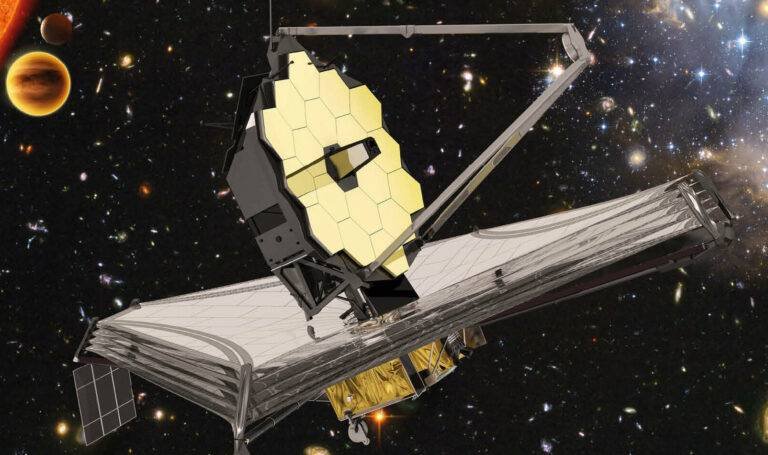The James Webb Space Telescope, NASA’s eagerly awaited new addition to its telescope array, has successfully completed its final run of tests, according to the space agency.
“NASA’s James Webb Space Telescope has reached a major turning point on its path toward launch with the completion of final observatory integration and testing,” according to Webb program director Gregory Robinson, who expressed enthusiasm about the telescope’s forthcoming launch in a recent NASA press release.
“We have a tremendously dedicated workforce who brought us to the finish line,” Robinson said, “and we are very excited to see that Webb is ready for launch and will soon be on that science journey.”
A joint project that will be managed between NASA and its partners at the European and Canadian space agencies, the James Webb Space Telescope will serve as the new flagship of NASA’s astrophysics mission, and successor to the legacy established by the Hubble Space Telescope. Designed for optimal detection of infrared wavelengths, among the objectives NASA has in mind for the telescope will be to scour the universe for evidence of some of its earliest galaxies and planetary systems.


The telescope was subjected to an impressive array of tests in recent days, which were undertaken at Northrup Grumman’s facilities in Falls Church, Virginia. According to a NASA statement, the regimen of tests had been “designed to ensure that the world’s most complex space science observatory will operate as designed” once it is launched into space.
The telescope, now having undergone its full range of tests and the completion of its final assembly stages, is on schedule for its forthcoming launch, and will soon embark on its journey to South America where its launch site at Kourou, French Guiana, awaits.
However, getting the telescope to its launch site all in one piece also brings with it a range of additional challenges. NASA has deployed a team of engineers and technicians who specialize in aspects ranging from transportation to contamination control, in order to ensure the safe movement and eventual launch of the telescope later this year.
As Webb makes its way south, engineering teams at its Mission Operations Center back in Baltimore at the Space Telescope Science Institute (STScl) will be focused on ensuring that the telescope’s communications systems are all in working order.
Tests involving Webb’s communications systems have been several years in the making.


“It’s a lot of going back and forth,” is how Carl Starr, Mission Operations Manager for Webb at NASA’s Goddard Space Flight Center in Greenbelt, Maryland, described his work with the Webb team as far back as 2018.
“You have to change configurations, you need a stable connection with Webb at each change, you have to establish the network connections, you have to process the data.
“And you have to do it multiple times with different stations and make it seamless,” Starr emphasized.
Considering the pandemic that has ensued since Starr’s initial statements on the challenges testing Webb’s communications systems faced in 2018, the team’s efforts have only become more demanding, although the Webb team was already used to having to coordinate between different teams in various parts of the world.
“We are talking about is in different places,” Starr said. “You have the Space Network out in New Mexico, the Deep Space Network in California, and the European Space Agency’s Malindi station in Kenya and European Space Operations Centre in Germany.” Starr says testing communications has become “a very complicated test to do, because no one is in the same time zone,” although all the data ultimately ends up in a single place.
“All of that data comes in and out of this building,” Starr said.
After Webb makes its way to its South American launch site in Kourou, the telescope will be inspected for any possible damage or other issues that might have occurred during its shipment from the United States. Once the telescope is thoroughly checked and its launch vehicle, an ESA Ariane 5 rocket, has been fitted for flight, the international team will then begin preparations for launch.


Mark Voyton, Webb observatory integration and test manager at NASA’s Goddard Space Flight Center in Greenbelt, Maryland, says he is “elated” to be participating in the launch, although he will be even happier once the launch has been executed successfully.
“To me, launching Webb will be a significant life event, Voyton said, mirroring the sentiments of countless NASA, ESA, and CSA personnel around the world who have contributed to getting the project to its current stage.
“Twenty years of my life will all come down to that moment,” Voyton was quoted saying in a NASA statement.
Although the launch that will carry it into space will last less than half an hour, the first six months of its mission will see the James Webb Space Telescope undergoing an intense commissioning period. During its first 30 days in space, Webb will fly nearly one million miles away from Earth to its operational orbiting position. As it travels, the telescope’s sunshield and other components will be deployed, gradually unfolding in controlled stages that a team at its Operations Center in Maryland will initiate and monitor.
The further Webb travels from Earth, the more it will cool as it gradually reaches a stable, but frigid operating temperature at its new home in orbit. As long as the meticulously planned deployment all goes according to plan, the James Webb Space Telescope will soon be operational and helping to usher in a new era of space studies and exploration as the world’s most impressive space science observatory.
Follow and connect with author Micah Hanks on Twitter: @MicahHanks

